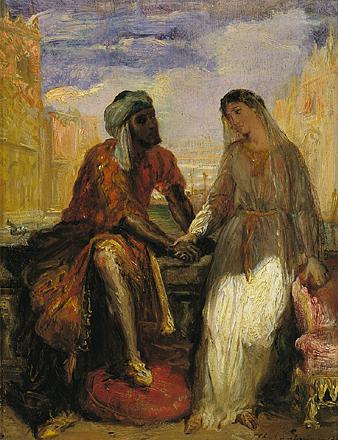
- The Tragedies - The Comedies - The Histories - The Sonnets
- The Life of Shakespeare - The Times of William Shakespeare - The Characters from Shakespeare - Stories and Plots
- Shakespeare Quotes - Doubtful Works - Site Map - More ...
Othello
Othello Plot SummaryOthello, a Moor who hasjust eloped with the white Desdemona when the play opens,leaves Venice to commandthe Venetian armies in Cyprus, accompanied by his new wife and lieutenantCassio. The treacherous standard-bearer, Iago, plants Desdemona's handkerchief on Cassio,managing to convince Othello that his wife has been unfaithful withthe lieutenant. Othello kills Desdemona out of jealousy, beforeIago's wife eventually reveals that Desdemona's affair was but aninvention of Iago's. Iago immediately kills his wife also, andOthello commits suicide in grief. Shakespeare's Sources for OthelloThe plot for Othello was developed from Giraldi Cinthio's Hecatommithi, which it follows closely.The only named character in Cinthio's story is "Disdemona", whichmeans "unfortunate" in Greek; the other characters were identifiedonly as "the standard-bearer", "the captain", and "the Moor". Inthe original, the standard-bearer lusts after Disdemona, and isspurred to revenge when she rejects him. Shakespeare invented a new character, Roderigo, who pursues theMoor's wife and is killed while trying to murder the captain.Unlike Othello, the Moor in Cinthio's story never repents ofmurdering his wife, and both he and the standard-bearer escapeVenice and are killed much later. Cinthio also drew a moral (whichhe placed in the mouth of the lady) that European women are unwiseto marry the hot-blooded, uncontrollable males of other nations;Shakespeare suppressed this observation. Othello's raceAlthough the play is very much concerned with racial difference,the protagonist's specific race is not clearly indicated byShakespeare. Othello is referred to as a "Moor"; forElizabethan Englishmen, this term could refer to the Muslim Arabs of North Africa, or to the people we would now call"Black" (that is, peopleof sub-Saharan African descent). Shakespearehad previously depicted an Arabic Moor in TheMerchant of Venice and a black Moor in TitusAndronicus. In Othello, the references to thecharacter's physical features do not settle the question of whichrace Shakespeare envisaged. Popular consensus among average readersand theatre directors today lean towards the "black"interpretation, and Arabic Othellos have been rare. Othello Themes and Tropes in OthelloSignifier / SignifiedOthello subverts traditional theatrical symbolism. Acontemporary audience would have seen black skin as a sign ofbarbarism orsatanism as Aaron isin Shakespeare's Titus Andronicus: a "swarth Cimmerian... ofbody's hue spotted, detested and abominable". A white soldier wouldhave been understood as a symbol of honesty. Iago indeed activelytries to convince other characters that Othello is a "barbaryhorse" that "covers" Desdemona, or a "black ram", horned andanimalistically "tupping" her; and that he himself is truthful to afault. In Othello, however, the black man is "noble" andChristian; and the white soldier is a scheming liar. Othello thus constantly challenges the link between aphysical signifier and what is signifiedby it. For example, Iago - whose job as standard-bearer is to holda sign of loyalty to Othello - says, of pretending to like theMoor: "Though I do hate him as I do hell pains/ Yet for necessityof present life/ I must show out a flag and sign of love/ Which isindeed but sign". Desdemona, too, sees a distinction betweensignifier and signified, saying she "saw Othello's visage in hismind" - not in his actual face. The play thus argues that therelationship between signifier and signifiedis arbitrary; the plot itself hinging on the significance anutterly "made-up" sign - a handkerchief made to signifyinfidelity. Othello's tragicflaw is thus that he is unable to cope with the notion that therelationship between signifier and signified is arbitrary. Forexample, when Iago tells him Desdemona is an adulteress, Othellocries "Her name, that was as fresh/ As Dian's visage, is now begrimed and black/ Asmine own face" - leading to a suicidal conclusion: "If there becords or knives/ Poison or fire, or suffocating streams/ I'll notendure it." Othello White / BlackThe most basic aspects of traditional Western symbology; that whitesignifies purity and black signifies evil - are thus repeatedlychallenged in Othello; . One example is in the character ofBianca. Her name in Italian means "white", yet, as Iago tells theaudience, her name is again "but sign" of purity, as she is in facta "hussy, that by selling her desires buys herself bread andclothes". Ironically, just before Desdemona pleads with Othellothat she is not a whore, Bianca too protests to an accuser that sheis "no strumpet, but of life as honest/ As you that thus abuse me"- leading the audience to realize that, just as with Desdemona, theonly evidence anyone has that Bianca is a whore is Iago's word. Othello by Shakespeare Heaven / HellHeaven neverthelessremains a signifier of truth, and hell a signifier of misrepresentation in the play. Thewords thus recur frequently throughout Othello, as Othellostruggles to join other signifiers to them: for example he says toan innocent Desdemona: "Heaven doth truly know that thou art falseas hell". List of CharactersPersons Represented:
Movie and Opera versions of OthelloShakespeare's Othello was also made into a movie several times, including:
The same story is the basis for two operatic versions, both called Otello, by Gioacchino Rossini and GiuseppeVerdi.
Retrieved from "http://en.wikipedia.org/wiki/William_Shakespeare" All text is availableunder the terms of the GNU Free Documentation License |
All Shakespeare | |||||||||||
Our Sponsors
-
- Study Guide - About Us- Privacy Policy - Site Map - Other Languages - Links - Link Exchange - More ...

![[advertisement]](ban10.gif)